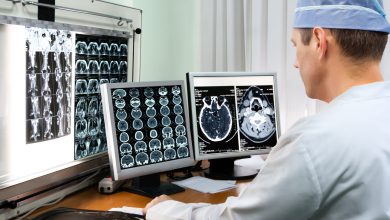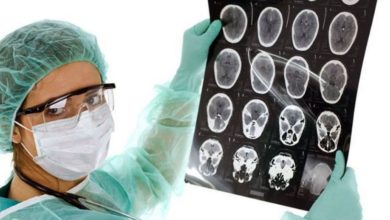Ependymoma - causes, symptoms, diagnosis and treatment
The content of the article
A rare type of cancer of the central nervous system is classified as ependymoma. This disease manifests itself as a result of mutation of cells in the brain or spinal cord. Based on the fact that such tumors arise in the central nervous system (CNS), they are also called primary. This means that they are not metastases from other malignant tumors that originated in other organs and only then reached the central nervous system.
Ependymoma is a fairly rare type of cancer of the central nervous system, the tumors of which can be either benign or malignant. As for the latter type, they come in varying degrees of malignancy. It is for this reason that some tumors develop very slowly, while others, on the contrary, grow very quickly. Due to the fact that the tumor grows quickly, it can very soon begin to put pressure on vital areas of the brain, so in this case, surgical intervention by a specialist is required. In the list of all known brain tumors, ependymomas account for 8%. Most often, this disease occurs in childhood, with most of the patients being children under 5 years of age. And also in childhood, it is malignant variants of this tumor that are more often detected.
Ependymoma - the cause of occurrence in children
Experts to this day cannot give an exact answer as to why such tumors arise and what exact mechanism is triggered that leads to the appearance of ependymoma. It is known that the risk of this tumor increases significantly if the child’s brain has been irradiated. It is noted that such a tumor often occurs as a result of treating a child for acute leukemia or eye cancer. Children with neurofibromatosis type 2 are at high risk of developing this tumor in the spine. Recent studies have shown that out of 1 million children, about 3 people are susceptible to this disease. It is also noted that boys get sick much more often than girls.
Types of ependymoma
- Subependymoma is a benign tumor that develops slowly;
- Myxopapillary – benign tumor;
- Anaplastic ependymoma is characterized by a malignant nature and is a second-degree cancer;
- Malignant anaplastic ependymoma grade 3.
The grade indicates the level of activity of the tumor, as well as its severity. The prognosis is influenced not only by the degree of the tumor, but also by its location, since some tumors may be located in places that are very difficult to reach for surgical intervention.
Ependymoma of the brain
Experts have discovered the SV40 virus, which is localized in ependymoma cells that are in an active state. But the role of this virus in tumor development is still unclear today.
There are suggestions that anaplastic ependymoma of the brain is caused by exposure to oncogenic factors that are common to other types of tumors. This includes radioactive radiation, chemical carcinogens, oncogenic viruses, etc. The involvement of a genetic factor cannot be ruled out.
Symptoms
The main feature of brain tumors is that they are localized in a very limited cavity of the brain, which is why sooner or later the tumor begins to affect both adjacent and distant parts of the brain.
Destruction or compression of tissue under the influence of tumor enlargement leads to the appearance of primary symptoms. During the active development of the tumor, general cerebral symptoms may appear, which were caused by cerebral edema, generalization of hemodynamic disorders, etc. If the tumor is located in the so-called “silent” area, then there may be no symptoms, and the disease itself will begin with general cerebral signs. In this case, focal manifestations may be absent altogether.
The main general cerebral symptom is headache , but this can also be a focal symptom, which is associated with the dura mater of the brain. Vomiting, which is a cerebral manifestation, is more common. With pituitary adenomas, visual disturbances are often observed.
Disorders of the functions of the cranial nerves also appear - loss of smell, pain or complete numbness of the face, hearing loss, disturbances in the digestive system, imbalance, etc.
As for focal symptoms, much depends on the location of the tumor and the affected areas. Movement disturbances, disturbances in the psyche and thought processes, visual disturbances, hormonal disturbances, impaired coordination, etc. may be observed.
Diagnosis of the disease
When a patient experiences severe liquor-hypertensive syndrome or an epileptic seizure that occurs for the first time, he is immediately sent for an MRI or CT scan of the brain. The first option is more effective, as it allows the specialist to obtain more detailed information and also eliminate radiation exposure to the patient, especially if we are talking about a child.
The patient may additionally be referred for electroencephalography, and also undergoes a consultation with an ophthalmologist, who will refer for direct ophthalmoscopy. To determine the extent of the tumor development process, a lumbar puncture is used, and cerebrospinal fluid is also examined. A complete diagnosis can only be obtained after a morphological study of the ependymoma material, which is obtained by stereotactic biopsy.
In addition to the options listed, the following studies may be required:
- Ultrasound;
- Vision assessment;
- Skin sensitivity;
- Diagnosis of reflex function;
- Neurological tests.
Treatment of ependymoma
Treatment of this tumor can be complex, surgical and radiation. The most optimal treatment option is its total destruction. When the tumor is located in the posterior cranial fossa, this causes certain difficulties for the neurosurgeon, which are associated with convenient access. If it is not possible to completely remove the tumor, then the operation is palliative.
In this case, shunt surgery can be used to improve the outflow of cerebrospinal fluid. To keep the recurrence rate of ependymoma to a minimum, after surgery the patient undergoes radiation therapy. If we are talking about surgery in young children, when the brain is still very vulnerable to radioactive radiation, radiation therapy should be greatly reduced or completely replaced with chemotherapy. The use of cytostatics is possible either instead of radiation therapy, or after it. The volume directly depends on the nature of the tumor, as well as its prevalence.
Subepindymoma or myxopapillary ependymoma after radical removal generally has a favorable prognosis. It is in this case that ependymoma is observed without relapse. As for the classic type, it is not always possible to completely remove it. Recurrence usually occurs at the site where the tumor originally appeared. If the removal was successful, the 5-year survival rate is estimated at up to 80%.
The most unfavorable prognosis is observed in the situation with anaplastic ependymoma, which is associated with its very rapid spread along the cerebrospinal fluid pathways. It is worth noting that if the ependymoma has been completely removed, cured people may complain of neurological symptoms, which are expressed by deterioration of vision and hearing. In the case of children, they are at high risk of exhibiting mental retardation.
Consequences
Due to the fact that ependymomas often occur in young children, and treatment occurs at the most important stage of the child’s development, long-term effects may persist. These include growth problems, changes in behavior and mental processes, problems with coordination and learning. Vision and hearing may be impaired both due to the tumor itself and as a result of treatment. There is also a small risk of developing cancer in the future.
After treatment of this tumor, all patients, regardless of its location, must undergo mandatory examination in an oncology clinic for a long time. This will allow you to quickly help with any long-term effects of treatment.
The main problems that patients may encounter after surgery are the following:
- In the case of children - delay in development and growth;
- Low ability to work or lack thereof;
- High fatigue and tendency to depression;
- Speech and hearing disorders;
- Development of hydrocephalus;
- Changes in the processes of perception of the environment;
- Possibility of seizures.
If a patient experiences these or other signs after surgery and treatment, then he needs to undergo special restorative procedures, as well as regularly visit specialists who will help detect metastases or other pathologies and prescribe the necessary treatment.
Chances of cure in children
The chance of recovery directly depends on what part of the tumor the specialist managed to remove during the operation. In children who had the tumor completely removed during surgery, and then the tumor region was irradiated, the five-year survival rate after treatment ranges from 60% to 75%. After 10 years, at the end of treatment, statistics give the following figures - from 55 to 60%.
If a relapse occurs, specialists initially check the likelihood of a new operation and radiation. Today, radiosurgical irradiation has proven to be very effective, which can significantly prolong the patient’s life. In addition, relapses of this tumor are very sensitive to the use of chemotherapy drugs. That is why this method of treatment significantly increases the statistics of a favorable prognosis in children and adolescents with recurrent brain tumors .
How to reduce the risk of ependymoma?
Unfortunately, there are currently no preventive measures that would prevent the development of ependymoma. But to reduce the likelihood of any brain tumor, you can follow generally accepted principles and lead a healthy lifestyle:
- To refuse from bad habits;
- Provide proper nutrition ;
- Minimize the negative impact of the environment;
- Regularly undergo medical examination;
- Carry out procedures to improve the immune system.
Please rate the article:





